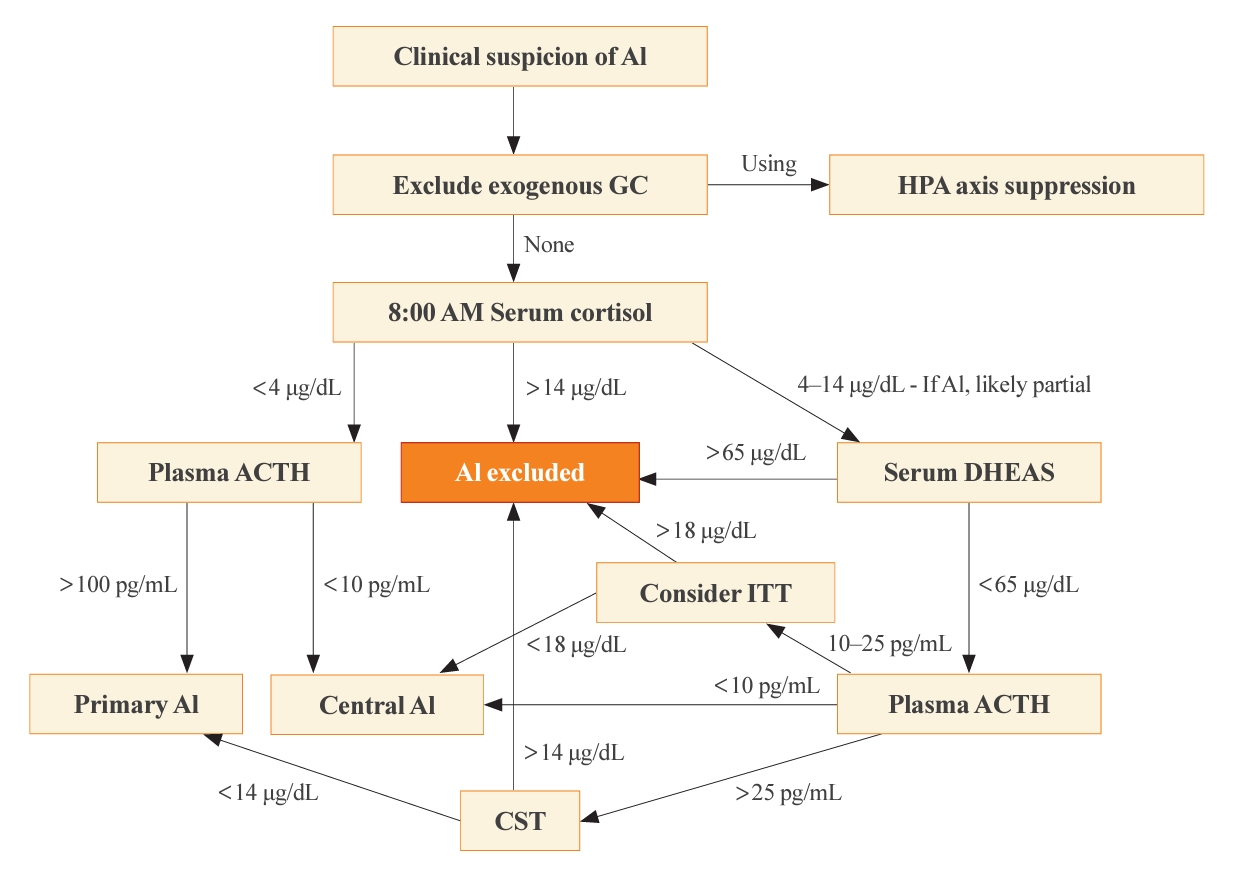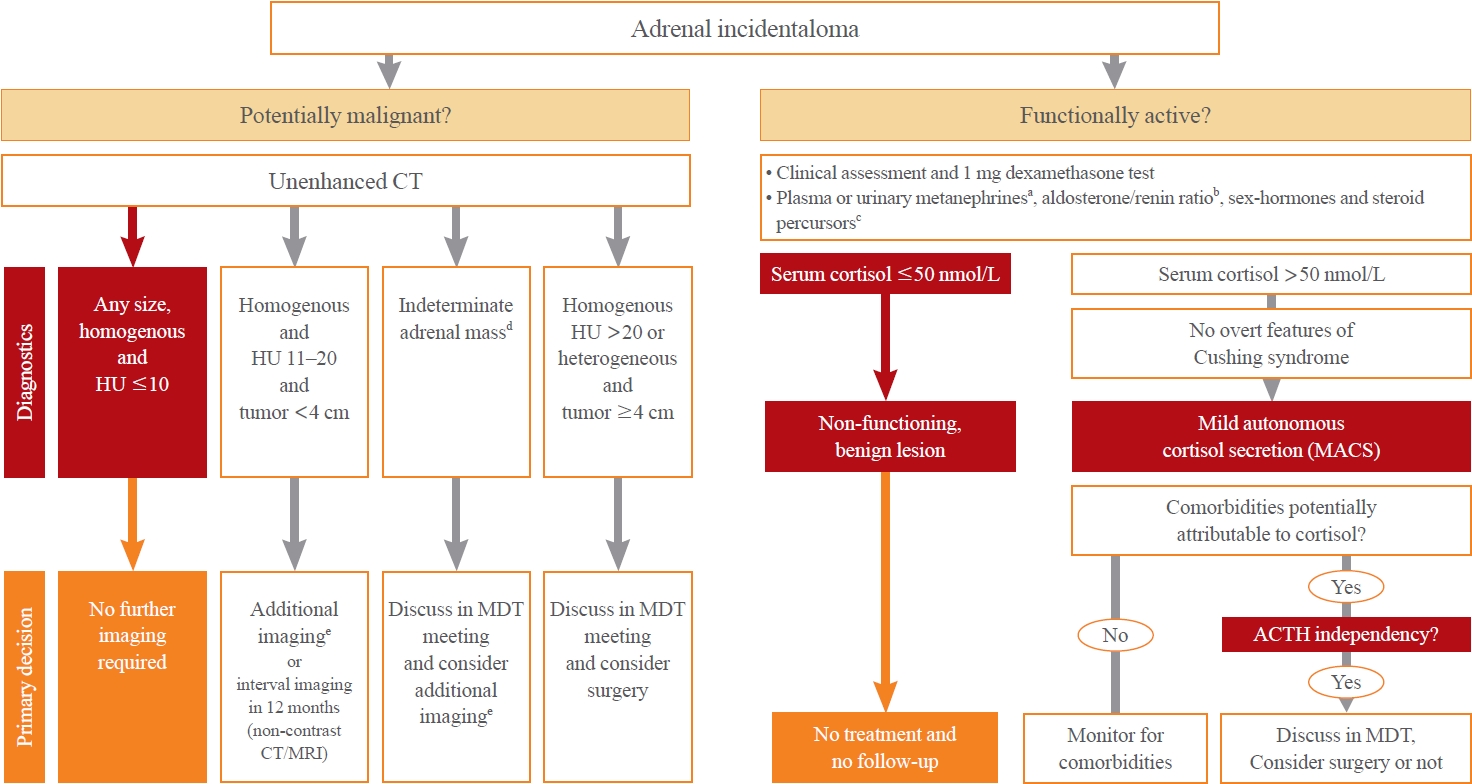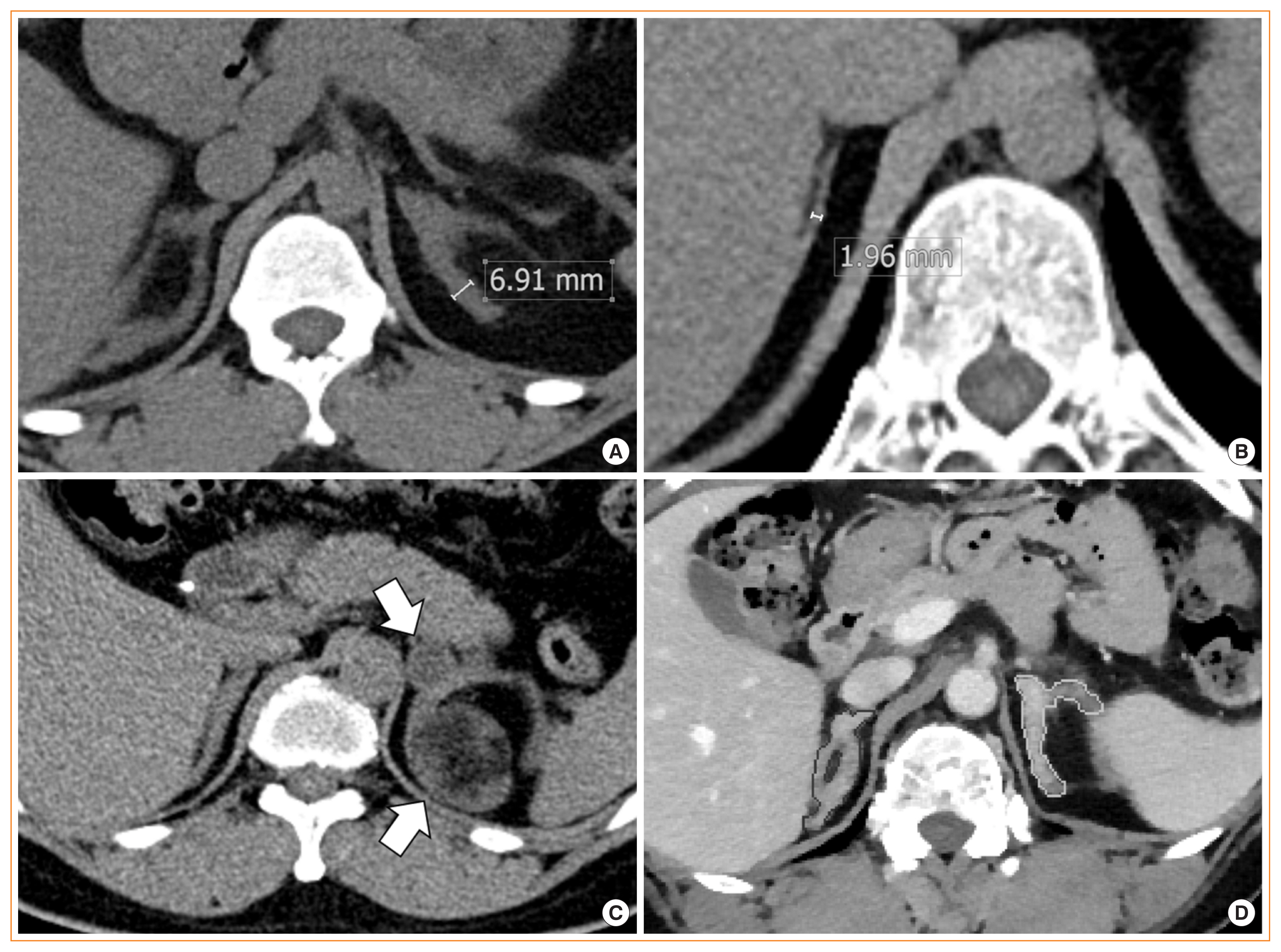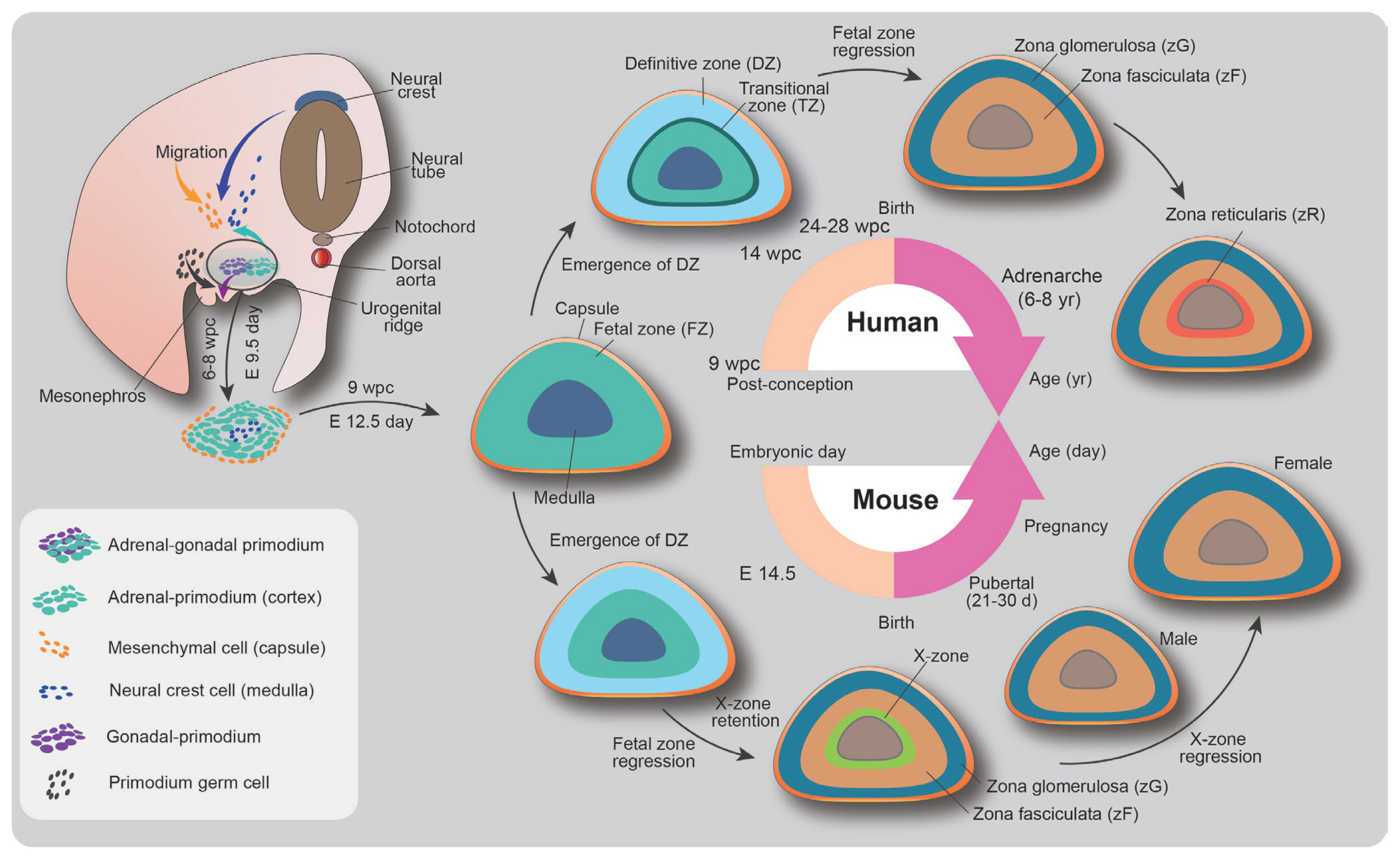Search
- Page Path
- HOME > Search
Review Articles
- Adrenal gland
- A Contemporary Approach to the Diagnosis and Management of Adrenal Insufficiency
- Suranut Charoensri, Richard J. Auchus
- Endocrinol Metab. 2024;39(1):73-82. Published online January 22, 2024
- DOI: https://doi.org/10.3803/EnM.2024.1894

- 2,493 View
- 245 Download
-
 Abstract
Abstract
 PDF
PDF PubReader
PubReader  ePub
ePub - Adrenal insufficiency (AI) can be classified into three distinct categories based on its underlying causes: primary adrenal disorders, secondary deficiencies in adrenocorticotropin, or hypothalamic suppression from external factors, most commonly glucocorticoid medications used for anti-inflammatory therapy. The hallmark clinical features of AI include fatigue, appetite loss, unintentional weight loss, low blood pressure, and hyponatremia. Individuals with primary AI additionally manifest skin hyperpigmentation, hyperkalemia, and salt craving. The diagnosis of AI is frequently delayed due to the non-specific symptoms and signs early in the disease course, which poses a significant challenge to its early detection prior to an adrenal crisis. Despite the widespread availability of lifesaving glucocorticoid medications for decades, notable challenges persist, particularly in the domains of timely diagnosis while simultaneously avoiding misdiagnosis, patient education for averting adrenal crises, and the determination of optimal replacement therapies. This article reviews recent advancements in the contemporary diagnostic strategy and approaches to optimal treatment for AI.

- Adrenal Gland
- Recent Updates on the Management of Adrenal Incidentalomas
- Seung Shin Park, Jung Hee Kim
- Endocrinol Metab. 2023;38(4):373-380. Published online August 16, 2023
- DOI: https://doi.org/10.3803/EnM.2023.1779

- 7,259 View
- 1,452 Download
-
 Abstract
Abstract
 PDF
PDF PubReader
PubReader  ePub
ePub - Adrenal incidentalomas represent an increasingly common clinical conundrum with significant implications for patients. The revised 2023 European Society of Endocrinology (ESE) guideline incorporates cutting-edge evidence for managing adrenal incidentalomas. This paper provides a concise review of the updated contents of the revised guideline. In the 2023 guideline, in patients without signs and symptoms of overt Cushing’s syndrome, a post-dexamethasone cortisol level above 50 nmol/L (>1.8 μg/dL) should be considered as mild autonomous cortisol secretion. Regarding the criteria of benign adrenal adenomas, a homogeneous adrenal mass with ≤10 Hounsfield units on non-contrast computed tomography requires no further follow-up, irrespective of its size. The updated guideline also discusses steroid metabolomics using tandem mass spectrometry to discriminate malignancy. It underscores the importance of high-volume surgeons performing adrenalectomy and emphasizes the pivotal role of a multidisciplinary team approach in deciding the treatment plan for indeterminate adrenal masses. The guideline advocates for more proactive surgical treatment for indeterminate adrenal masses in young patients (<40 years) and pregnant women. This review of the 2023 ESE guideline underscores the ongoing evolution of the adrenal incidentaloma management landscape, emphasizing the need for further research and adaptation of diagnostic and therapeutic strategies.

Original Article
- Adrenal Gland
- Adrenal Morphology as an Indicator of Long-Term Disease Control in Adults with Classic 21-Hydroxylase Deficiency
- Taek Min Kim, Jung Hee Kim, Han Na Jang, Man Ho Choi, Jeong Yeon Cho, Sang Youn Kim
- Endocrinol Metab. 2022;37(1):124-137. Published online February 8, 2022
- DOI: https://doi.org/10.3803/EnM.2021.1278

- 4,244 View
- 126 Download
- 6 Web of Science
- 6 Crossref
-
 Abstract
Abstract
 PDF
PDF PubReader
PubReader  ePub
ePub - Background
Monitoring adults with classical 21-hydroxylase deficiency (21OHD) is challenging due to variation in clinical and laboratory settings. Moreover, guidelines for adrenal imaging in 21OHD are not yet available. We evaluated the relationship between adrenal morphology and disease control status in classical 21OHD.
Methods
This retrospective, cross-sectional study included 90 adult 21OHD patients and 270 age- and sex-matched healthy controls. We assessed adrenal volume, width, and tumor presence using abdominal computed tomography and evaluated correlations of adrenal volume and width with hormonal status. We investigated the diagnostic performance of adrenal volume and width for identifying well-controlled status in 21OHD patients (17α-hydroxyprogesterone [17-OHP] <10 ng/mL).
Results
The adrenal morphology of 21OHD patients showed hypertrophy (45.6%), normal size (42.2%), and hypotrophy (12.2%). Adrenal tumors were detected in 12 patients (13.3%). The adrenal volume and width of 21OHD patients were significantly larger than those of controls (18.2±12.2 mL vs. 7.1±2.0 mL, 4.7±1.9 mm vs. 3.3±0.5 mm, P<0.001 for both). The 17-OHP and androstenedione levels were highest in patients with adrenal hypertrophy, followed by those with normal adrenal glands and adrenal hypotrophy (P<0.05 for both). Adrenal volume and width correlated positively with adrenocorticotropic hormone, 17-OHP, 11β-hydroxytestosterone, progesterone sulfate, and dehydroepiandrosterone sulfate in both sexes (r=0.33–0.95, P<0.05 for all). For identifying well-controlled patients, the optimal cut-off values of adrenal volume and width were 10.7 mL and 4 mm, respectively (area under the curve, 0.82–0.88; P<0.001 for both).
Conclusion
Adrenal volume and width may be reliable quantitative parameters for monitoring patients with classical 21OHD. -
Citations
Citations to this article as recorded by- Long‐term health consequences of congenital adrenal hyperplasia
Riccardo Pofi, Xiaochen Ji, Nils P. Krone, Jeremy W. Tomlinson
Clinical Endocrinology.2023;[Epub] CrossRef - Landscape of Adrenal Tumours in Patients with Congenital Adrenal Hyperplasia
Mara Carsote, Ana-Maria Gheorghe, Claudiu Nistor, Alexandra-Ioana Trandafir, Oana-Claudia Sima, Anca-Pati Cucu, Adrian Ciuche, Eugenia Petrova, Adina Ghemigian
Biomedicines.2023; 11(11): 3081. CrossRef - Multiplexed Serum Steroid Profiling Reveals Metabolic Signatures of Subtypes in Congenital Adrenal Hyperplasia
Jaeyoon Shim, Chang Ho Ahn, Seung Shin Park, Jongsung Noh, Chaelin Lee, Sang Won Lee, Jung Hee Kim, Man Ho Choi
Journal of the Endocrine Society.2023;[Epub] CrossRef - Long-Term Outcomes of Congenital Adrenal Hyperplasia
Anna Nordenström, Svetlana Lajic, Henrik Falhammar
Endocrinology and Metabolism.2022; 37(4): 587. CrossRef - Congenital adrenal hyperplasia in patients with adrenal tumors: a population-based case–control study
F. Sahlander, J. Patrova, B. Mannheimer, J. D. Lindh, H. Falhammar
Journal of Endocrinological Investigation.2022; 46(3): 559. CrossRef - Fully automatic volume measurement of the adrenal gland on CT using deep learning to classify adrenal hyperplasia
Taek Min Kim, Seung Jae Choi, Ji Yeon Ko, Sungwan Kim, Chang Wook Jeong, Jeong Yeon Cho, Sang Youn Kim, Young-Gon Kim
European Radiology.2022; 33(6): 4292. CrossRef
- Long‐term health consequences of congenital adrenal hyperplasia

Review Article
- Adrenal gland
- Embryonic Development and Adult Regeneration of the Adrenal Gland
- Ji-Hoon Kim, Man Ho Choi
- Endocrinol Metab. 2020;35(4):765-773. Published online December 23, 2020
- DOI: https://doi.org/10.3803/EnM.2020.403

- 7,899 View
- 366 Download
- 15 Web of Science
- 17 Crossref
-
 Abstract
Abstract
 PDF
PDF PubReader
PubReader  ePub
ePub - The adrenal gland plays a pivotal role in an organism’s health span by controlling the endocrine system. Decades of research on the adrenal gland have provided multiscale insights into the development and maintenance of this essential organ. A particularly interesting finding is that founder stem/progenitor cells participate in adrenocortical development and enable the adult adrenal cortex to regenerate itself in response to hormonal stress and injury. Since major advances have been made in understanding the dynamics of the developmental process and the remarkable regenerative capacity of the adrenal gland, understanding the mechanisms underlying adrenal development, maintenance, and regeneration will be of interest to basic and clinical researchers. Here, we introduce the developmental processes of the adrenal gland and discuss current knowledge regarding stem/progenitor cells that regulate adrenal cortex remodeling and regeneration. This review will provide insights into the fascinating ongoing research on the development and regeneration of the adrenal cortex.
-
Citations
Citations to this article as recorded by- Update on Adrenarche—Still a Mystery
Philipp Augsburger, Jani Liimatta, Christa E Flück
The Journal of Clinical Endocrinology & Metabolism.2024;[Epub] CrossRef - Aging induces region-specific dysregulation of hormone synthesis in the primate adrenal gland
Qiaoran Wang, Xuebao Wang, Beibei Liu, Shuai Ma, Feng Zhang, Shuhui Sun, Yaobin Jing, Yanling Fan, Yingjie Ding, Muzhao Xiong, Jiaming Li, Qiaocheng Zhai, Yandong Zheng, Chengyu Liu, Gang Xu, Jiayin Yang, Si Wang, Jinlin Ye, Juan Carlos Izpisua Belmonte,
Nature Aging.2024; 4(3): 396. CrossRef - Adrenal Dysfunction in Mitochondrial Diseases
Madeleine Corkery-Hayward, Louise A. Metherell
International Journal of Molecular Sciences.2023; 24(2): 1126. CrossRef - Effects of very low-calorie ketogenic diet on hypothalamic–pituitary–adrenal axis and renin–angiotensin–aldosterone system
L. Barrea, L. Verde, E. Camajani, A. S. Šojat, L. Marina, S. Savastano, A. Colao, M. Caprio, G. Muscogiuri
Journal of Endocrinological Investigation.2023; 46(8): 1509. CrossRef - Post‐hatching developmental changes in the adrenal gland of the Japanese quail (Coturnix coturnix japonica): Histological, immunohistochemical, and electron microscopic studies
Fatma M. Abdel‐maksoud, Saher Fadl, Ahmed Abou‐Elmagd, Abdelmohaimen M.M. Saleh
Microscopy Research and Technique.2023; 86(11): 1461. CrossRef - Interactive metabolic signatures of testicular testosterone with bilateral adrenalectomy in mice
Hae Lim Cho, Ji-Hoon Kim, Seuk-Min Ryu, Jongsung Noh, Sang Won Lee, Man Ho Choi
The Journal of Steroid Biochemistry and Molecular Biology.2023; 231: 106333. CrossRef - Construction of a novel clinical nomogram to predict cancer-specific survival in patients with primary malignant adrenal tumors: a large population-based retrospective study
Mingzhen Li, Xiaoying Duan, Di You, Linlin Liu
Frontiers in Medicine.2023;[Epub] CrossRef - The anti-platelet drug cilostazol enhances heart rate and interrenal steroidogenesis and exerts a scant effect on innate immune responses in zebrafish
Wei-Chun Chang, Mei-Jen Chen, Chung-Der Hsiao, Rong-Ze Hu, Yu-Shan Huang, Yu-Fu Chen, Tsai-Hua Yang, Guan-Yi Tsai, Chih-Wei Chou, Ren-Shiang Chen, Yung-Jen Chuang, Yi-Wen Liu, Mohammed Fouad El Basuini
PLOS ONE.2023; 18(10): e0292858. CrossRef - Regulation of Morphogenetic Processes during Postnatal Development and Physiological Regeneration of the Adrenal Medulla
S. S. Obernikhin, N. V. Yaglova, E. P. Timokhina, S. V. Nazimova, V. V. Yaglov
Bulletin of Experimental Biology and Medicine.2023; 175(4): 549. CrossRef - Distinct HAND2/HAND2-AS1 Expression Levels May Fine-Tune Mesenchymal and Epithelial Cell Plasticity of Human Mesenchymal Stem Cells
Rachel Vazana-Netzarim, Yishay Elmalem, Shachar Sofer, Hod Bruck, Naama Danino, Udi Sarig
International Journal of Molecular Sciences.2023; 24(22): 16546. CrossRef - An Update on Genetics of Adrenal Gland and Associated Disorders
Chester Gauss, Dustin Rowland, Berrin Ergun-Longmire
Endocrines.2022; 3(2): 187. CrossRef - Immune dysfunction after spinal cord injury – A review of autonomic and neuroendocrine mechanisms
Kyleigh A. Rodgers, Kristina A. Kigerl, Jan M. Schwab, Phillip G. Popovich
Current Opinion in Pharmacology.2022; 64: 102230. CrossRef - Clinical and Technical Aspects in Free Cortisol Measurement
Man Ho Choi
Endocrinology and Metabolism.2022; 37(4): 599. CrossRef - Surrénalectomies
Isabelle Valin, Dan Rosenberg
Le Nouveau Praticien Vétérinaire canine & féline.2022; 19(82): 50. CrossRef - Adrenal medulla development and medullary-cortical interactions
Nicole Bechmann, Ilona Berger, Stefan R. Bornstein, Charlotte Steenblock
Molecular and Cellular Endocrinology.2021; 528: 111258. CrossRef - Theory: Treatments for Prolonged ICU Patients May Provide New Therapeutic Avenues for Myalgic Encephalomyelitis/Chronic Fatigue Syndrome (ME/CFS)
Dominic Stanculescu, Lars Larsson, Jonas Bergquist
Frontiers in Medicine.2021;[Epub] CrossRef - Unravelling Polycystic Ovary Syndrome and Its Comorbidities
Kyung-Wook Kim
Journal of Obesity & Metabolic Syndrome.2021; 30(3): 209. CrossRef
- Update on Adrenarche—Still a Mystery

Case Report
- A Case Report of Bilateral Adrenocortical Carcinoma Complicated by Adrenal Insufficiency.
- Min Joo Kim, Jung Hee Kim, Tae Young Kim, Sang Wan Kim
- Endocrinol Metab. 2011;26(3):243-247. Published online September 1, 2011
- DOI: https://doi.org/10.3803/EnM.2011.26.3.243
- 2,005 View
- 29 Download
- 2 Crossref
-
 Abstract
Abstract
 PDF
PDF - Adrenocortical carcinoma is often functional and presents with signs and symptoms of adrenal steroid hormone excess. Adrenal insufficiency secondary to bilateral adrenocortical carcinoma is a particularly rare complication. We recently encountered a case of bilateral adrenocortical carcinoma complicated by adrenal insufficiency. A 52-year-old male was transferred to this hospital complaining of general weakness and weight loss. A bilateral adrenal mass was detected on abdomen CT. Plasma cortisol and aldosterone failed to rise during the rapid ACTH stimulation test. The CT-guided adrenal biopsy revealed findings consistent with adrenocortical carcinoma. Left hemiparesis was developed and brain metastasis was detected via brain MRI. Despite the application of gamma knife surgery and chemotherapy, the disease progressed and the patient died.
-
Citations
Citations to this article as recorded by- Bilateral Adrenocortical Carcinoma Presenting as Acute Adrenal Insufficiency
Anshita Aggarwal, Aprajita Verma, Aparajita Roy, Bindu Kulshreshtha
European Endocrinology.2020; 16(2): 172. CrossRef - A Case of Bilateral ACTH-independent Adrenal Adenomas with Cushing's Syndrome Treated by Ipsilateral Total and Contralateral Partial Laparoscopic Adrenalectomy
Seung Ah Park, Dong min Jung, Soon young Kim, Nan Young Choi, Tae-jun Kim, Yong kyun Kim, Seong kyun Na, Chul Sik Kim, Seong Jin Lee, Sung-Hee Ihm, Jun Goo Kang
The Korean Journal of Obesity.2013; 22(4): 254. CrossRef
- Bilateral Adrenocortical Carcinoma Presenting as Acute Adrenal Insufficiency


 KES
KES

 First
First Prev
Prev



